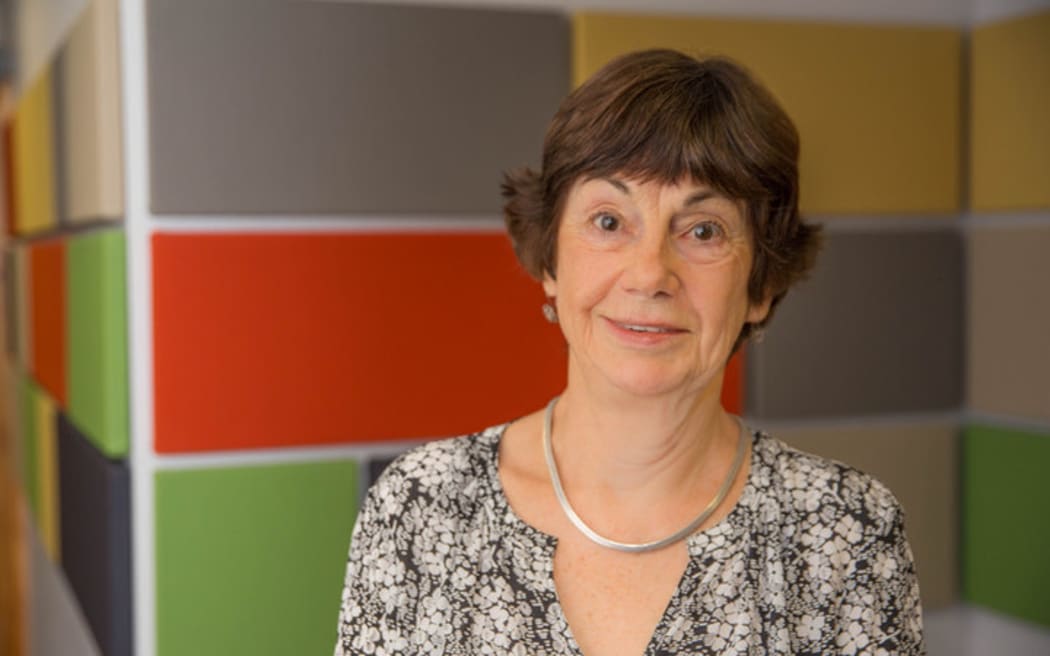Mary Holm discusses three ways to play with numbers.
The first is dollar cost averaging, how if you invest regularly - in KiwiSaver or elsewhere - you buy bargains even if you don't realise it.

Mary Holm Photo: RNZ/Cole Eastham-Farrelly
The second is the rule of 72. This can quickly tell you how long it takes for an investment to double. And if your investment has already doubled, what your return was.
The third compares what happens if you have 40 years in KiwiSaver in a low risk versus a high risk fund.
In a high-risk fund you can end up with three times as much as in a low-risk fund.
And if you choose a low-fee fund you can end up 1.5 times as much as in a high-fee fund.
Start early, go with higher risk and lower fees, is her message.
Dollar Cost Averaging
Mary says this happens automatically in any investment where the balance can go up and down as the markets go up and down, and you are putting in a regular amount to the fund.
She uses the seasonal variation in the price of asparagus as a metaphor.
“Let’s say you’re willing to spend $10 on asparagus and in the height of the asparagus season it costs $2 a bunch, so for your $10 you’re going to get 5 bunches.
“In the depths of winter when there’s no local asparagus around it might cost $10 a bunch because it’s imported.
“So your average price is between $2 and $10 - which is $6.
“So you’ve bought 5 bunches in summer and 1 bunch in winter you’ve got 6 bunches and the average price is $6, so you would think the total you’ve spent is 6 times $6 which is $36, but you’ve actually only spent $20 - $10 in the summer for your 5 bunches and $10 in the winter for your 1 bunch.”
In other words you’ve only spent $20 and it feels like you’ve got $36 worth, she says.
The principle is you’ve bought more when the price is cheap, and a similar principle applies to an investment fund like KiwiSaver, she says.
“If you’re feeding into a KiwiSaver account when the units in the KiwiSaver account are cheap, you’re going to get more; when the market’s gone down you are going to buy more units, when the markets gone up you’re going to buy fewer units.
“That means you buy bargains, you get more when they are cheaper. It automatically happens.”
But what if you have a lump sum to invest from a sale of a house or an inheritance? Mary holds to the belief that drip feeding it in is the best way to go.
“If you put the whole lot in in one go and then the markets go down soon after you’re going to feel really sick, and they might stay down for quite a long time. Psychologically it’s easier if you say I’m going to put a quarter in now and another quarter in 2 or 3 months and so on.”
The rule of 72
This is a numbers game that applies to one-off investments, she says.
For example you might want to calculate how long it will take for your investment to double.
“If I inherited $10,000 and I want it to get to $20,000, how long will it take to do that? If you were in an investment that was paying you 4 percent a year, you’d divide 4 into 72 and the answer to that is 18 and that tells you it’s going to take 18 years to double.”
Conversely if an investment you’ve made had doubled and you want to know what return you’ve made, you divide the time it’s taken to double into 72 - if it’s taken 16 years you’ve returned 4.5 percent a year; ten years 7.2 percent.
KiwiSaver over the long term
If you’re in KiwiSaver for 40 years and you invest in a high risk fund, you’ll have almost three times as much in a high risk fund as a low risk fund, Mary says.
“It’s a huge, huge difference and it’s really good if people can get the courage to go into that high risk fund over the long term.”
And watch you’re fees too she says, around 1 percent she advises, any more is too much.
“If you go with the lowest fee, high risk KiwiSaver currently available you’ll end up with about one and a half times as much.
“It’s a really good idea to get in early, go with high risk and go with low fees.”

